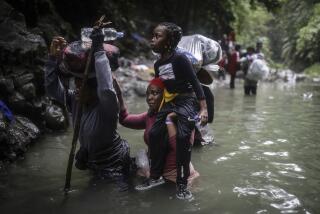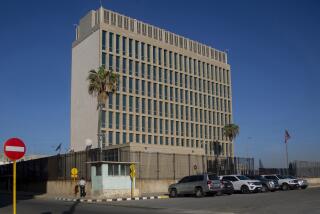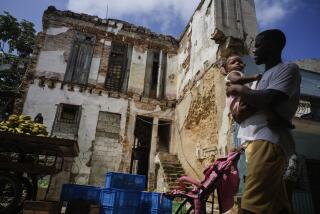Cuba, suspended in time
FATHER John Bakas walked the crowded cobblestone streets of Old Havana, dined on spicy red beans and rice at an outdoor cafe and led vesper services at a 2-year-old Greek Orthodox Church near Havana Bay. Several members of his congregation, St. Sophia Greek Orthodox Cathedral in Los Angeles, joined him on the November trip, his third to Cuba.
At the same time, Kim Zimmerman, a Los Angeles pediatrician on her first trip to Cuba, was visiting the capital with a group of healthcare workers on a tour designed by Global Exchange, a San Francisco human rights organization. She watched young dancers in colorful folk costumes swirl across a makeshift dance floor at a hospital for Down syndrome children, then joined them for a few moments, earning hugs and broad smiles from the troupe.
Bakas and Zimmerman were among an estimated 40,000 U.S. residents who visited the off-limits island of Cuba last year. Despite tough new sanctions from the Bush administration, about 2 million tourists traveled to Cuba in 2005. Most were from Canada and Europe, but U.S. citizens came too.
Some, like Bakas and Zimmerman, visited legally on authorized tours, but many did not, defying U.S. regulations by flying to Havana from Canada, Jamaica, the Bahamas or Mexico.
Regardless of how they arrive, most tourists are drawn by Cuba’s legendary mystique. It is an intoxicating destination for travelers, a place of fine rum and cigars; sugary-white Caribbean beaches; attractive, friendly people; unbelievable ‘50s kitsch; potent music and dance; and a wealth of untouched Spanish Colonial architecture.
Once a U.S. playground, Cuba has been forbidden fruit for its giant neighbor to the north since the U.S. trade embargo began more than four decades ago. For some, that makes it all the more inviting.
When I visited in November — journalists are allowed to travel to Cuba — I interviewed tourists who were there legally and some who traveled there without U.S. permission. After I returned home, I spoke with others in the latter category, whose names I have not used because they could be subject to fines and prosecution.
“I think everyone who really wants to go [to Cuba] finds a way to get there,” said a San Pedro woman who visited Havana last summer, entering by way of Mexico.
Welcome to yesteryear
THE Havana of long ago isn’t hard to find. I needed only to step outside José Martí International Airport to vault backward in time. Old Studebakers, DeSotos and Oldsmobiles were everywhere, their horns honking and black smoke belching. In town, the 75-year-old Hotel Nacional, onetime host to notables such as Winston Churchill and Frank Sinatra, overlooked the blue waters of the Straits of Florida in serene elegance. And down along the 7.5-mile seafront boulevard — the Malecón — couples embraced or strolled arm-in-arm.But that night, when I heard a conga drum and the words, “Babalú, babalú, babalú,” I really sensed I’d entered a time warp. Desi Arnaz wasn’t here, but the Tropicana was, still entertaining guests on its stage under the stars just as it has since 1939. Six platforms from rooftop to aisle were full of swirling dancers in gauzy costumes, many parading hats that could have doubled as hotel chandeliers. Men toked on fat cigars, couples mixed rum-and- cola drinks at their tables and guests swayed to the steamy rhythms of the music.
As my week in Cuba unfolded, I explored Havana on foot and by pedicab, horse-drawn carriage and taxi. The city swept by in indelible images: live chickens being hawked by habaneros to earn extra cash; front-stoop musicians jamming for their neighbors; young ballerinas practicing pirouettes in a storefront studio; newlyweds smiling broadly as they rolled down the Malecón atop a gleaming ’52 Chevy convertible, the bride’s long white veil streaming behind her in the wind.
Like most tourists, I stayed in Old Havana, La Habana Vieja, the historical core. It was founded in 1514 — more than 50 years before St. Augustine, Fla., the oldest continuously occupied city in the U.S.
Old Havana is a warren of narrow cobblestone avenues lined with Baroque buildings that have changed little since the 17th and 18th centuries. The street life is vibrant, the surroundings impressive. One of my first stops was the fifth-floor room at the Hotel Ambos Mundos, where Ernest Hemingway worked on his 1940 novel “For Whom the Bell Tolls.”
My self-guided walking tour took me to Plaza de Armas, the city’s oldest square, a beautifully landscaped park where booksellers barter with tourists and residents. I walked a few hundred yards farther to Castillo de la Real Fuerza, the oldest stone fort in the Americas, and listened as a guide explained an archeological dig and restoration project underway.
Restoration — I heard the word often in La Habana Vieja. During the last decade charming hotels, cafes and shops have emerged from the disheveled ruins of once-beautiful mansions.
Neglected for more than four decades, Havana is rife with imperfections: Sewage runs in the streets; water pipes won’t work; abandoned structures, some converted into slum housing, collapse overnight. Thomas Paul, a Tucson fireman/paramedic visiting with the Global Exchange group, said much of the city would be condemned if it were in the U.S.
When Fidel Castro’s rebel army won victory in 1959, life changed irreversibly for the Cuban people; it changed again in 1990 when the Soviet Union departed, taking its financial subsidies with it.
Cubans have little cash — incomes range from about $10 to $18 a month — and supplies are hard to come by. A ration system allows each person eight eggs, 6 pounds of rice, 3 pounds of beans and 2 pounds of sugar monthly. But Cubans also have universal healthcare and an effective education system.
Despite the economic hardships, residents have a contagious energy and enthusiasm. They savor life, are warm to visitors and are passionate about their famous city. They’re good-humored too, sharing jokes and stories about life in a Communist regime. “Havana has 2 million people,” one man told me, “and 1 million police.”
There’s speculation about life after Castro, who has been in power since Dwight D. Eisenhower was president. “When the dog is dead,” a habanero told me, “there is no rabies.”
In the back door
HE’S a Chicago businessman who loves Cuba. He visits frequently and has used backdoor travel when he couldn’t find a legal way to enter the country. He was caught when a Cuban customs official stamped his passport and a U.S. Customs official noticed it. He wasn’t fined, but he thinks his name went onto a list.“I should be able to travel anywhere I want in the world,” he said. “I can go to other Communist countries like China or Vietnam. Why not Cuba?”
Backdoor travelers risk more than being on a list. U.S. penalties can range from a warning letter to $65,000 fines. But many play the game anyway, saying they enjoy the thrill of doing something forbidden.
Some are experienced travelers drawn to the lost-in-time ambience of Cuba. Others are sex travelers seeking a destination where prostitution is common. Still others say they want to see Cuba before it changes. During my visit, I met a young couple from Atlanta who had been in Jamaica on vacation, were bored and decided to detour to Havana for a couple of days.
The Cuban government cooperates with backdoor travelers; customs officials generally do not stamp the passports of Americans when they enter. “All travelers are legal as far as we’re concerned,” said Miguel Alejandro Figueras, a Cuban tourism official.
U.S. sanctions limiting travel to Cuba have waxed and waned in the last four decades. Travel loosened up during the Clinton administration; it tightened up during the Bush administration.
“Castro uses travel-related dollars to bankroll his regime on the backs of the Cuban people,” said Molly Millerwise, a Treasury Department spokeswoman. “The Bush administration is steadfast in its commitment to hasten the day when the Cuban people can enjoy the same free lives we enjoy in America.”
But many backdoor travelers say free travel is their constitutional right. “Making it difficult for us to visit doesn’t help the Cuban people. It just makes life harder for them,” said the Chicago businessman. “I think tougher restrictions have more to do with the politics of Florida than anything else,” he said, speculating that President Bush and his brother, Florida Gov. Jeb Bush, are influenced by the Cuban exile community in Miami.
Backdoor travelers usually play down the hazards, but the U.S. government managed to ferret out about 500 of them between January and October last year.
“If you do get caught, it’s probably going to cost you $1,000 to $2,000, if you’re represented by an attorney,” said Oakland lawyer Bill Miller, who has done pro bono work for about 100 clients who faced fines for visiting Cuba. “If you ignore it [the warning letter], then it will be sent to collection and you’re going to owe $7,500, plus interest.”
Outside the city
WE were driving west, away from the heavy pollution and crowded streets of Havana. Cuba, about the size of Pennsylvania, was turning into a land of mountains, beaches and vast farmlands.A multilane autopista was taking us into Pinar del Río province, past tobacco plantations, verdant grasslands and farmers tilling ocher-colored fields with teams of oxen.
The highway itself offered entertainment: Billboards bore revolutionary sayings and advice; hawkers stood at the side of the road selling cheese, grilled chickens and live turkeys; huge groups of hitchhikers hid from the tropical heat under overpasses.
About three hours outside Havana, we reached Valle de Viñales, where oddly shaped mounds of limestone tower over a patchwork quilt of farms. The scenery was striking, but more interesting were the people, many of them guajiros, Cuban peasant farmers. We stopped to talk to several; all were gracious, telling us about their fields and crops.
We saw few tourists on the road. Although Cuba’s tourism industry is one of the fastest-growing in the world, most visitors see only the country’s beach resorts or Havana.
Varadero, about 100 miles east of Havana, draws many Canadians and Europeans to its surfside hotels, which stretch along a sandy isthmus facing the Straits of Florida. It’s a magnet for budget travelers. Canadians can purchase a weeklong, all-inclusive vacation for $700, including airfare. More than 600,000 arrived last year.
Cuba continues to expand tourist facilities, planning new resorts and encouraging foreign investment in hopes of luring more Canadian, European and Latin American tourists. But the big plum is just next door.
“The highest spenders are Americans,” said Figueras, the tourism official. “We want them to come. We think they want to come.”
He’s hopeful that change is on the horizon. If it is, will Cuba be ready?
“The first million American tourists will be no problem. But give us notice for the second million.”
*
(BEGIN TEXT OF INFOBOX)
Cuba: on the inside
GETTING THERE
U.S. regulations are complicated, but basically, only three groups of travelers are allowed easy access to Cuba: U.S. officials on government business, full-time professionals traveling for research or to attend conferences and full-time journalists. These groups are allowed to travel under a general license, meaning they do not need to fill out an application to go there. Others can visit Cuba if they apply for and obtain a specific license from the U.S. government; these licenses are granted for a variety of reasons, including travel for educational, religious or humanitarian purposes. Family members who wish to visit relatives in Cuba must also obtain a specific license. For more details, see the Treasury Department overview “What You Need to Know About the Cuban Embargo,” https://www.treas.gov/offices/enforcement/ofac/sanctions/t11cuba.pdf .
Americans who travel to Cuba from a third country, such as Mexico, Canada, Jamaica or the Bahamas, risk fines and criminal prosecution. In general, travel agencies abroad that claim they can arrange legal travel for U.S. citizens to Cuba are misstating the facts.
Technically, it’s illegal for Americans to spend money in Cuba. All air and hotel arrangements must be booked through a U.S. authorized travel agency, such as:
Marazul Charters, 4100 Park Ave., Weehawken, NJ 07086; (877) 756-1433, https://www.marazul.com , is a government-approved agency; it is allowed to make hotel reservations or book flights to Cuba from Miami, Mexico, Canada, Jamaica, the Dominican Republic and the Bahamas.
A limited number of tours for professionals are scheduled in 2006 by Global Exchange, 2017 Mission St., Suite 303, San Francisco, CA; (415) 255.7296, https://www.globalexchange.com . Among the eight research delegations planned are sessions focusing on Cuban healthcare, architecture, psychology, the legal system and the educational system. The weeklong tours cost $2,350.
TELEPHONES:
To call the numbers below from the U.S., dial 011 (the international dialing code), 53 (country code for Cuba), 7 (city code for Havana) and the local number.
WHERE TO STAY:
Hotel Santa Isabel, 9 Calle Baratillo, Old Havana; 860-8201, https://www.cuba.tc/havana/santaisabel.html . Once the home of royalty, this lovely 17th century building has been renovated and has an excellent location overlooking Plaza de Armas and the Port of Havana. Nice ambience; bar, restaurant, Internet access. $185 per night with breakfast.
Hotel Telégrafo, 408 Prado, Old Havana; 861-1010, https://www.cuba.tc/havana/telegrafo.html . Built in the late 19th century and renovated in 2002, this eclectic hotel has spacious rooms and a broad terrace from which to watch the city. $140 per night with breakfast.
Hotel Parque Central, Neptune at Prado and Zulueta, Old Havana; 860-6627, https://www.hotelparquecentral.com . One of the city’s best hotels. Modern, efficient, with a rooftop pool, fitness center and air conditioning. $170 per night, with breakfast.
WHERE TO EAT:
La Barraca, at the Hotel Nacional, Calle 21, Esquina O, Vedado, Havana; 873-3564, https://www.hotelnacionaldecuba.cu . There are several good restaurants at this famed Havana hotel. La Barraca is the only one offering traditional Cuban cuisine. Entrees $12 to $18. Other good bets here: Tour the hotel’s impressive grounds and see the lively Cabaret Parisién show.
La Flor de Loto, 13 Salud, central Havana; 863-5450. Most tourist restaurants in Havana are pricey, but this Asian restaurant in Havana’s Chinatown has good food and prices. Dinner entrees start at about $5.
Restaurant Caracola, 469 Calle Monserrate, Old Havana. Tented patio dining. Excellent pizza and pastas. Entrees $2 to $7.75.
TO LEARN MORE:
The Cuban Tourist Board has an English-language website. Go to https://www.gocuba.ca .
— Rosemary McClure
More to Read
Sign up for The Wild
We’ll help you find the best places to hike, bike and run, as well as the perfect silent spots for meditation and yoga.
You may occasionally receive promotional content from the Los Angeles Times.






